MACHEREY-NAGEL has developed NucleoBond® Xtra, a new generation of anion exchangers based on the patented NucleoBond® technology. With NucleoBond® Xtra typical yields of ≥ 250 μg (Midi) or ≥ 1000 μg (Maxi) of ultra-pure plasmid DNA can be obtained in about half of the time compared to other Midi and Maxi kits based on anion-exchange chromatography.
NucleoBond® Xtra Midi and Maxi kits contain enlarged columns which leads to lower silica resin beds. This in turn enables faster flow of lysate and buffers through the columns. Specially designed column filters are included for convenient and time-saving clarification of bacterial lysates. The column filters are supplied inserted in the NucleoBond® Xtra columns and allow parallel clarification of bacterial lysate and loading onto the column. Their large, structured surface leads to high filter flow rates and minimized risk of clogging. The improved silica material with greater DNA binding capacity is based on the proven NucleoBond® anion-exchanger group MAE, methylaminoethanol (patented technology). Optimized buffer compositions additionally lead to improved alkaline lysis and increased column flow rates.
Bacteria are harvested from an overnight culture and lysed by an optimized alkaline lysis procedure. The bacterial lysate is cleared and loaded onto the equilibrated column in one step (plasmid DNA binds to the anion-exchange resin). The first washing step using equilibration buffer is performed with inserted column filter to wash out residual lysate from the filter and obtain maximum recovery of DNA. After subsequent washing, the purified plasmid DNA is eluted in a high-salt buffer and precipitated with isopropanol. Precipitation can be performed by centrifugation (NucleoBond® Xtra Midi or Maxi) or by using the NucleoBond® Finalizer / Finalizer Large included in the NucleoBond® Xtra Midi Plus/Maxi Plus kits to reduce the total prep time to about 30 minutes (Midi Plus) or 35 minutes (Maxi Plus).
LyseControl — for highest yields
The new LyseControl, included in the NucleoBond® Xtra procedure, visualizes a complete neutralization for efficient alkaline lysis. LyseControl is a blue reagent premixed for your convenience with Lysis Buffer LYS. Upon addition of lysis buffer to the resuspended cells (Fig. A), the cell suspension turns blue (Fig. B). The blue solution is gently inverted 5 times and incubated for 5 min to avoid contamination with genomic DNA. Upon addition of Buffer NEU (Fig. C) to neutralize the lysate, LyseControl turns colorless. Traces of blue LyseControl (Fig. D) indicate an insufficient mixing. This step removes SDS, renatures plasmid DNA, and precipitates proteins and genomic DNA. Hence, it prevents filterclogging, maximizes plasmid DNA yield, and minimizes contamination.
| A |
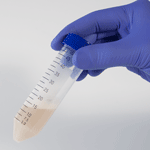
|
Cell pellet in resuspension buffer (RES) |
| B |
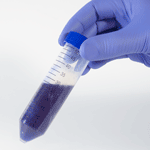
|
Addition of lysis buffer (LYS - including LyseControl) to cell suspension. The cell suspension turns blue. |
| C |
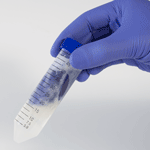
|
Addition of neutralization buffer (NEU).
LyseControl starts turning colorless
– start mixing. |
| D |
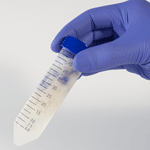
|
Traces of blue LyseControl still visible
– insufficient mixing. |
| E |
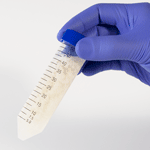
|
LyseControl turned completely colorless
– sufficient mixing. |
Customer Testimonial
"We have tested many of the market leaders in anion-exchange purification, and the MACHEREY-NAGEL NucleoBond® Xtra kits excel in ease of use, speed of preparation, yield and DNA quality." - Enrique Saez, PhD, The Genomics Institute of the Novartis Reserach Foundation, San Diego, CA, USA
|
Application data
Higher plasmid yield in less time – comparison to competitor anion-exchange based kits
Plasmid DNA was isolated following each manufacturer's protocol using the maximum culture volume with high plasmid content. Yield of plasmid DNA was determined after DNA precipitation. Comparison: A) Kits including desalting tool, B) Kits without desalting tool.
NucleoBond® Xtra: Up to 60% time saving and up to 100% higher yields compared to competitor products.
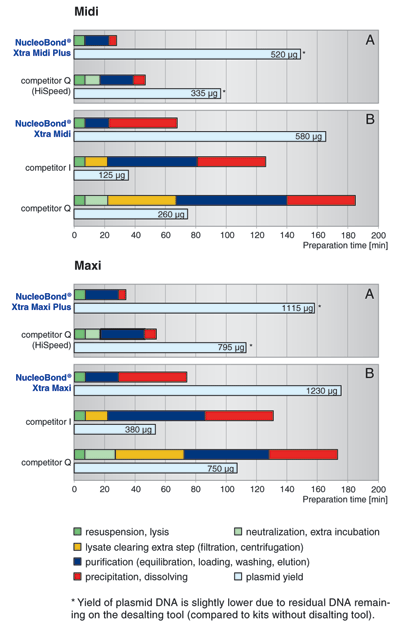
Preparation time and plasmid yield – comparison to silica-membrane based kits
Plasmid DNA was isolated following each manufacturer's protocol using the maximum culture volume with high plasmid content. Yield of plasmid DNA was determined after precipitation (NucleoBond® Xtra) and after elution from the column (competitor kits) respectively.
NucleoBond® Xtra also beats silica-membrane based kits in terms of yield and prep time... not to mention superior purity of plasmid DNA due to anion-exchange technology.


Comparison of transfection efficiencies using NucleoBond® Xtra Maxi and a competitor product respectively
Plasmid purification: 6 kb high-copy plasmid, bacterial strain: E.coli DH5a®, purification according to each manufacturers’ protocol using the maximum culture volume with high plasmid content.
NucleoBond® Xtra Maxi: plasmid yield: 1222 μg, purity A260/A280: 1.84
Product Q (Maxi prep): plasmid yield: 557 μg, purity A260/A280: 1.86
Transfection experiment: HEK293 cells transfected in 12-well plates, 2.5 x 104 cells/well, transfection with 0.1–0.25 μg plasmid DNA/well, transfection reagent: FuGENE® HD/6 (Roche, 1.5 μL/well), results shown after 48 hours.
Results: HEK293 cells transiently expressing Gephyrin (Polypeptide, associated with the postsynaptic receptor complex, with a key role in organization of the postsynaptic membrane) fused to EGFP (Enhanced Green Fluorescent Protein) as a reporter.
| NucleoBond® Xtra Maxi |
product Q |
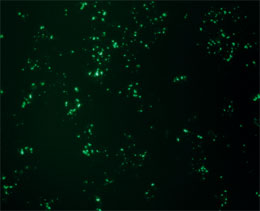
|
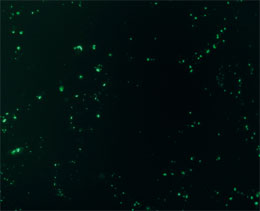
|
NucleoBond® Xtra Maxi shows higher transfection efficiency than competitor Q.
Data kindly provided by Prof. Dr. Guenter Schwarz, Institute of Biochemistry, University of Cologne, Germany
Customer Testimonial
"We compared transfection efficiencies of different plasmids purified with market leading kits based on anion-exchange technology. Plasmid DNA purified with NucleoBond® Xtra from MACHEREY-NAGEL gave overall best results and high transfection efficiencies even if only small amounts of DNA were used for transfection." - Prof. Dr. Guenter Schwarz, Institute of Biochemistry, University of Cologne, Germany
|
Transfection of HEK293 cells with NucleoBond® Xtra Midi purified plasmid DNA
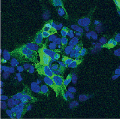
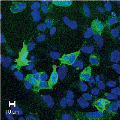 Plasmid purification: NucleoBond® Xtra Midi, 6.5 kb high copy plasmid, 200 mL LB overnight culture, bacterial strain: E. coli DH5a®, reconstitution in 300 μL TE buffer, plasmid yield: 381 μg, purity A260/A280: 1.93.
Plasmid purification: NucleoBond® Xtra Midi, 6.5 kb high copy plasmid, 200 mL LB overnight culture, bacterial strain: E. coli DH5a®, reconstitution in 300 μL TE buffer, plasmid yield: 381 μg, purity A260/A280: 1.93.
Transfection experiment: HEK293 cells transfected in 6-well plates, 3.5 x 105 cells/well, transfection with 0.4 μg plasmid DNA/well, method of transfection: Effectene® (Qiagen).
Results: HEK293 cells transiently expressing VSVG (Vesicular Stomatitis Virus Glycoprotein) fused to EGFP (Enhanced Green Fluorescent Protein) as a reporter. Nuclei were counterstained with TO-PRO®3 (Molecular Probes).
The high transfection efficiency was verified by visualizing the EGFP.
Data kindly provided by Tsutomu Nakamura, Department of Molecular and Genetic Information, Institute of Molecular and Cellular Bioscience, University of Tokyo, Japan.
Ultrapure plasmid DNA for automated capillary sequencing
BigDye™-terminator sequence of pUC18 plasmid DNA from E. coli XL1-Blue purified with the NucleoBond® Xtra Maxi kit. DNA sequence was analyzed on an ABI 3730xl DNA Analyzer.
Click for downloadng the sequencing profile as a pdf file
Purification and subsequent restriction of several constructs
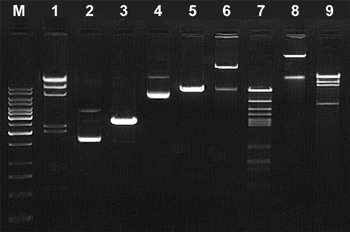 Four plasmids different in size were purified with NucleoBond® Xtra Midi from DH5a® grown in LB medium. For analysis 1 μg each was digested with EcoRI. Undigested and EcoRI digested samples were electrophoretically separated on a 1% TAE agarose gel.
Four plasmids different in size were purified with NucleoBond® Xtra Midi from DH5a® grown in LB medium. For analysis 1 μg each was digested with EcoRI. Undigested and EcoRI digested samples were electrophoretically separated on a 1% TAE agarose gel.
M: marker (1kbp standard, MBI Fermentas)
1: lHindIII
2: pUC18 (2.6 kbp), 3: pUC18 EcoRI
4: pcDNA (8.6 kbp), 5: pcDNA EcoRI
6: cosmid DNA (49 kbp), 7: cosmid EcoRI
8: BAC DNA (168 kbp), 9: BAC DNA EcoRI
The high purity of plasmid DNA is demonstrated by restriction analysis.
NucleoBond® Xtra Combi Rack
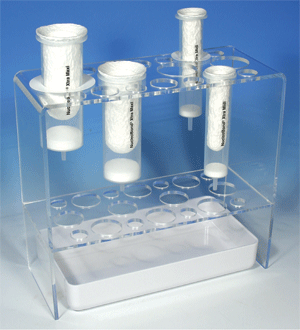
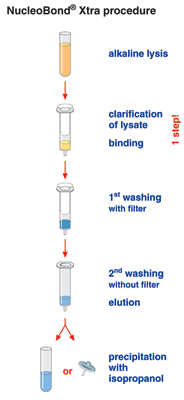











 Plasmid purification: NucleoBond® Xtra Midi, 6.5 kb high copy plasmid, 200 mL LB overnight culture, bacterial strain: E. coli DH5a®, reconstitution in 300 μL TE buffer, plasmid yield: 381 μg, purity A260/A280: 1.93.
Plasmid purification: NucleoBond® Xtra Midi, 6.5 kb high copy plasmid, 200 mL LB overnight culture, bacterial strain: E. coli DH5a®, reconstitution in 300 μL TE buffer, plasmid yield: 381 μg, purity A260/A280: 1.93. Four plasmids different in size were purified with NucleoBond® Xtra Midi from DH5a® grown in LB medium. For analysis 1 μg each was digested with EcoRI. Undigested and EcoRI digested samples were electrophoretically separated on a 1% TAE agarose gel.
Four plasmids different in size were purified with NucleoBond® Xtra Midi from DH5a® grown in LB medium. For analysis 1 μg each was digested with EcoRI. Undigested and EcoRI digested samples were electrophoretically separated on a 1% TAE agarose gel.